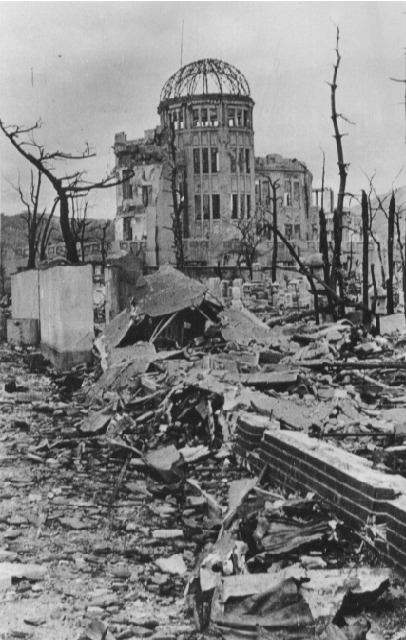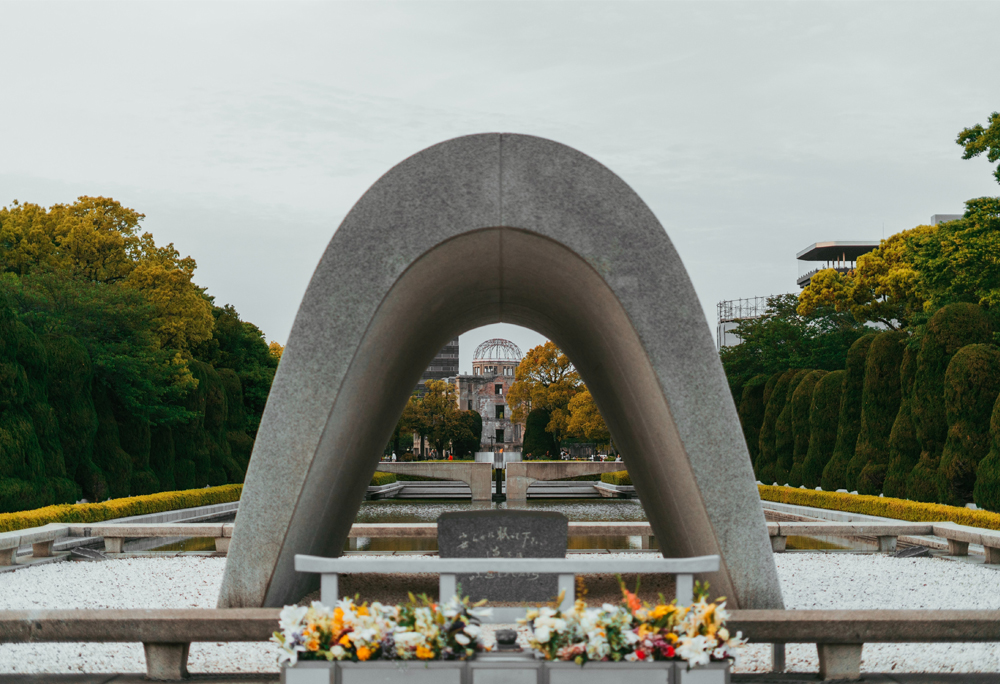Choosing Peace
The Key to Avoiding Another Hiroshima
It’s been 75 years since deployment of the first atomic bomb. Are we any closer to global peace?
At 8:15 a.m. on the nearly cloudless morning of August 6, 1945, residents of Hiroshima were settling in to their daily routines. But at that moment, from a height of nearly six miles, an American warplane was dropping an atomic bomb on the Japanese city. In 43 seconds, the world would change forever.
An estimated 80,000 people succumbed immediately when the bomb exploded overhead; thousands more would die later as a result of radiation poisoning. Four square miles of the city suffered utter destruction. Three days later a second bomb fell on Nagasaki. About 40,000 people died in an instant, with thousands more to follow.
Paul Tibbets was the commander of Enola Gay, the aircraft that delivered the first bomb. In a 1982 interview he described the smoke and debris he had seen below: “After the bomb exploded, you couldn’t see that there was a city down there at all; it was covered with a—the only way I can describe it is it looked like a black, boiling mess of tar.”
Humankind for millennia has sought new technologies to gain advantage over military opponents. Spear throwers, longbows, Greek fire, gunpowder, cannons, rifled weapons, minié balls, machine guns, rocket launchers—the drum beat out an increasingly ominous cadence as weapons boasted ever-greater killing and destructive power.
The drumbeat continued with the creation of Little Boy and Fat Man, the names given those first atomic weapons. Their genesis was a letter signed by Albert Einstein, drafted in August 1939 in collaboration with physicist Leo Szilard and delivered to US president Franklin D. Roosevelt. The letter warned of Germany’s potential for developing an atomic weapon and urged “quick action on the part of the Administration” to counter the threat. As a result the United States began its own atomic program, code-named the Manhattan Project.
The lens of time offers a great advantage when evaluating historic decisions. On that August morning in 1945, the world was plunged into a nuclear arms race of existential proportions. Since then the world has trembled in uncertainty at the presence of these weapons in the arsenals of nations.
A Just War?
It’s remarkable, in retrospect, that nuclear arms developers gave so little thought to the morality of the technology. Scientific advancement is often divorced from moral or ethical responsibilities, instead leaving such discussions to philosophy, ethics or religion. The project thus went forward without a moral or ethical North Star or guiding principle, and without considering future risks to humanity. The fear of a German weapon was enough to drive researchers forward.
“We cannot look at the so-called grimmer aspects of it, because there is no morality in warfare. So I don’t dwell on the moral issue.”
Western nations have long looked to “just war theory” to defend military action, finding in it a cleansing of wartime behavior. Leaders base their right to go to war on a set of principles known as jus ad bellum. A commonly invoked “just cause” is self-defense against aggression, although this has been broadly applied to intervening in a public evil or injustice in another nation. The theory also specifies that war must be a last resort, be declared by a proper authority, stem from right intentions, and have a reasonable chance of success, and that the ends must be proportional to the means. This final point overlaps with a second set of principles, jus in bello, which specifies right conduct in war, including a prohibition against killing civilians. (As might be expected, of course, there’s no wide agreement on exactly how to interpret or apply these principles, especially if one side sees the other as subhuman.)
People have pondered the concept of just war for millennia, with early Christian discussion attributed to Ambrose (ca. 339–397 CE) and Augustine (354–430 CE). Thomas Aquinas further developed the theory roughly 900 years later, providing theological and systematic conscience-based underpinnings for the pursuit of war. In a footnote of history, US Air Force chaplain George Zabelka blessed the crew of Enola Gay before their fateful mission, underscoring the belief that the bomb was a just measure in a just war.
Robert Oppenheimer, widely recognized for guiding the Manhattan Project to successful completion, had no qualms about deploying the bomb; he was certain that it had been necessary for defeating fascism and thus saving democracy. Overwhelmingly the physicists involved in the project felt justified, considering the aggressions of Hitler and the added fear that his scientists might manufacture an atomic bomb first.

An October 1945 photo shows the skeletal remains of the Hiroshima Prefectural Industrial Promotion Hall. When the atomic bomb exploded over the city, about 160 meters (525 feet) southeast of this building, everyone inside was killed. The structure, now known as the Genbaku Dome or A-Bomb Dome, has been preserved and in 1996 became a World Heritage Site as a perpetual reminder to the world and as a symbol of global peace.
But there was another, less convenient, truth. Oppenheimer commented in 1954, “When you see something that is technically sweet, you go ahead and do it and you argue about what to do about it only after you have had your technical success.” Famed Australian physicist Sir Mark Oliphant is quoted as saying, “I learned during the war that if you pay people well and the work’s exciting they’ll work on anything. There’s no difficulty getting doctors to work on biological warfare, chemists to work on chemical warfare and physicists to work on nuclear warfare.”
The moral landscape did shift somewhat when Germany surrendered on May 7, 1945. It shifted further as the true power of the new weapons became more obvious. After observing the July 1945 nuclear test explosion at Alamagordo, New Mexico, Oppenheimer recalled a quote from the Hindu Bhagavad Gita: “Now I am become Death, the destroyer of worlds.” He saw more clearly the enormity of power and destruction that was about to be unleashed on the Japanese, both military and civilian.
Some scientists and physicists in the Manhattan Project grew increasingly hesitant regarding use of the bomb against Japan—not so much whether it should ever be used, which seemed by then a foregone conclusion, but how and under what conditions. The dawning realization of the potential for unimaginable devastation gave them pause. But their creation was now in the hands of political and military leaders.
Concerned about their moral responsibilities, they circulated a petition addressed to President Truman: “. . . The development of atomic power will provide the nations with new means of destruction. The atomic bombs at our disposal represent only the first step in this direction, and there is almost no limit to the destructive power which will become available in the course of their future development. Thus a nation which sets the precedent of using these newly liberated forces of nature for purposes of destruction may have to bear the responsibility of opening the door to an era of devastation on an unimaginable scale. . . . In view of the foregoing, we, the undersigned, respectfully petition . . . that you exercise your power as Commander-in-Chief, to rule that the United States shall not resort to the use of atomic bombs in this war unless the terms which will be imposed upon Japan have been made public in detail and Japan knowing these terms has refused to surrender. . . .”
“If after the war a situation is allowed to develop in the world which permits rival powers to be in uncontrolled possession of these new means of destruction, the cities of the United States as well as the cities of other nations will be in continuous danger of sudden annihilation.”
Although 70 scientists signed the petition, it’s likely that Truman never saw it before the bomb was dropped. Without apparent regard for what deployment might portend, the president assumed that fewer American and Japanese lives would be lost in bringing the war to a conclusion than if conventional weapons were used; proponents saw the bomb as a lifesaving measure.
In November 1945, Oppenheimer tried to put the project in perspective: “When you come right down to it the reason that we did this job is because it was an organic necessity. If you are a scientist you cannot stop such a thing. If you are a scientist you believe that it is good to find out how the world works; that it is good to find out what the realities are; that it is good to turn over to mankind at large the greatest possible power to control the world and to deal with it according to its lights and its values.” Yet that power now included the ability to end life on the planet.
From World War to Cold War
War seemed to demand creation of these “ultimate weapons.” At war’s end, both Germany and Japan lay defeated and crippled. A long, deep breath at that moment would have allowed time to consider the need for peaceful coexistence with the world community rather than enhancing the capabilities of nuclear weapons. Why did this not happen?
The answer is found in a document that, with pinpoint accuracy, described Joseph Stalin’s aggressive mindset on foreign policy and international relations. George Kennan, the US chargé d’affaires in Moscow, wrote a “long telegram” describing the USSR’s belief that there could be “no permanent peaceful coexistence” with the capitalist West. He described Russia’s plans for an aggressive campaign to position their national interest in direct opposition—economically, politically and militarily—to the West.
The United States and its allies responded with a policy of “containment” aimed at limiting the advance of Soviet influence in the world. As a result, the two powers embarked on a different type of conflict, a “cold” war that called for a vast expansion of nuclear capabilities.
By the 1950s, atomic weapons had given way to hydrogen weapons that were potentially 2,500 times more powerful than the device used on Hiroshima, and leading thinkers grew increasingly concerned. In July 1955 Bertrand Russell and Einstein issued a manifesto warning against further use of nuclear arms.
Speaking “as human beings, members of the species Man, whose continued existence is in doubt,” they asked, “Shall we put an end to the human race; or shall mankind renounce war?” The document ended with a resolution: “In view of the fact that in any future world war nuclear weapons will certainly be employed, and that such weapons threaten the continued existence of mankind, we urge the governments of the world to realize, and to acknowledge publicly, that their purpose cannot be furthered by a world war, and we urge them, consequently, to find peaceful means for the settlement of all matters of dispute between them.”
“We have not yet found that the views of experts on this question depend in any degree upon their politics or prejudices. They depend only, so far as our researches have revealed, upon the extent of the particular expert’s knowledge. We have found that the men who know most are the most gloomy.”
As long as the potential for conflict between nation-states has existed, there have been efforts to deter such conflict; for example, building sufficient military capability to either intimidate or defeat the enemy, or making the price of an enemy’s victory too high.
But the rise of nuclear weapons altered this approach. With the ability to inflict maximum harm on soldier, civilian and infrastructure from the opening stages of a conflict, “mutually assured destruction” (MAD) became the standard defense of the superpowers.
Growing Risks
In the intervening 75 years, many have analyzed the usefulness of a nuclear arsenal and the existential risks it poses. Currently eight nations are known to have nuclear weapons: United States, Russia, United Kingdom, France, China, India, Pakistan and North Korea. Israel is also assumed to have them, and many believe that Iran and Syria have each worked toward a bomb of their own.
The historical record points to nuclear weapons being largely ineffective as a deterrent to war. Military action still occurs with troubling frequency. This suggests an urgent need to resolve such issues as nuclear weapons proliferation, growing membership in the nuclear arms community, inaccurate threat assessment, command and control interruptions, and accidental launches.
But there are more-troubling reasons to reconsider the nuclear path. Several key players in past US policies on international relations (among them former US senator Sam Nunn, former defense secretary William Perry, and former secretaries of state George Schultz and Henry Kissinger) have pointed to the escalating risk of nuclear instability between the United States and Russia. In an op-ed published in the Wall Street Journal in 2011, they asked, “Can we devise and successfully implement with other nations, including other nuclear powers, careful, cooperative concepts to safely dismount the nuclear tiger . . . ?” As we mark the 75th anniversary of the event that started it all, the question is no less important.
In recent years we’ve seen growing tension between Russia and the United States stemming from political involvement in the Balkans, Kosovo, Syria, etc.; NATO enlargement; the Iraq War; Russia’s invasions of Georgia and Ukraine and its annexation of Crimea; and alleged Russian interference in other nations’ elections.
This tension, combined with reduced communication between the two nations and the sunsetting of many arms-control agreements, prompted Nunn to address a 2019 roundtable at the Hoover Institution (a public policy think tank at Stanford University). His comments were based on a 2007 WSJ op-ed, also cowritten with Schultz, Perry and Kissinger. “Unless urgent new actions are taken,” they had said, “the U.S. soon will be compelled to enter a new nuclear era that will be more precarious, psychologically disorientating, and economically even more costly than was Cold War deterrence.”

Near the center of the Hiroshima Peace Memorial Park, this arch stands over a cenotaph bearing the names of all those who were killed by the bomb. The arch frames the nearby A-Bomb Dome.
Janus-Faced
Why does humankind continually place itself at the precipice? If, when offering a blessing on the Enola Gay crew, Air Force chaplain Zabelka had been asked to identify the source of war, he might well have referred to the biblical book of James: “What causes fights and quarrels among you? Don’t they come from your desires that battle within you? You desire but do not have, so you kill. You covet but you cannot get what you want, so you quarrel and fight” (James 4:1–2). The apostle’s first-century audience wasn’t the world at large, but his point is nevertheless instructive.
Steven Pinker, a psychologist and cognitive scientist at Harvard University, acknowledges that the human brain is predisposed toward violence—influenced by tribalism, a thirst for revenge and a quest for dominance. But he thinks humanity can outgrow these warlike tendencies, observing that the human brain is also capable of empathy, “the ability to get into other people’s heads, feel their pain, and perhaps think twice before harming them,” and reason, “cognitive processes that can engage in objective, detached analysis and see violence itself as a problem to be solved instead of a contest to be won.”
Writing in Psychology Today, psychologist and evolutionary biologist David P. Barash echoes Pinker. He describes humankind as “both nasty and nice, war-mongering and peace-seeking, spawn of the devil and responsive to the better angels of our nature.”
“When it comes to matters of war and peace, our evolutionary bequest . . . is Janus-faced: it looks in two, quite different directions, in this case toward war as well as toward peace.”
Regrettably, national leaders “only occasionally represent the best of what humanity has to offer,” writes Alex Lickerman, a medical doctor. “They suffer from the same three poisons as the populations they lead: greed, anger, and stupidity. The true cause of war lies in the unchecked rampaging of these three poisons through the hearts of individual people.” We hear echoes of the apostle James’s words in this analysis.
Why can’t we harness “the better angels of our nature” in a quest for peace? Lickerman asks, “If in civilized societies we expect people to work out their differences amicably . . . , why don’t those same expectations apply to differences between civilized countries?” Bold initiatives—the League of Nations, the 1928 Kellogg-Brand Pact, the United Nations—have aimed at just that: resolving international disputes without resorting to war. But sabers continue to rattle, and we still confront the potential of a life-ending nuclear event.
In his 2019 comments at the Hoover roundtable, Nunn noted that the world has indeed entered “a new nuclear era” and that nuclear powers should recognize “existential common interests” as foundational for the future. He presented several ideas for reducing the risk, including recognizing the inherent danger in anyone “having a finger on the trigger.”
If the nuclear community were to agree to a broad rollback to reduce the threat of annihilation, the world could rightly rejoice. But would it be enough? As Oppenheimer indicated, science and technology move forward, ethical considerations notwithstanding. Someone will develop other life-threatening weapons.
One is compelled to ask why? Why does the world community, in its own common interest, not insist on peace? Lickerman hits on the answer, observing that “the real path to world peace can’t be found in the passing of more laws, in diplomacy, or even in war itself. It can only be found in the actions individual human beings take to reform the tenets they hold in their hearts. . . . World peace exists literally in the actions each one of [us] takes in our own lives. . . . When people come to deeply believe in notions that promote peace, peace will follow like a shadow follows the body.”
Assessing our own approach to peace and how we interact one with another individually is the place to start. “Love your neighbor as yourself,” said Jesus, a man universally recognized as the embodiment of peace. But He also said, “Love your enemies.” That’s a hard saying until we come to see that kindness overcomes hate, and that hate only breeds more hate.
Beginning early in life, we all nurture an oversized concern for self to the disadvantage of others. We see it on playgrounds, in backyards, on school grounds. Pinker described the motives as revenge, tribalism, a quest for dominance. We become adept at solving problems through conflict rather than through peacemaking. It’s no surprise that those who go on to be leaders in society or the military tend to be greater experts in aggressive posturing than in peace efforts.
Shifting collective attitudes is difficult if not impossible unless we each, whatever our citizenship, miraculously undergo a simultaneous change of heart, because the pathway to peace is manifest in the actions we take individually. Can we shed the darker motives in our nature and practice peace so that a Hiroshima or Nagasaki will never happen again? Absent the resolve to consciously choose peace as our way of life, we can only expect history to repeat itself.


